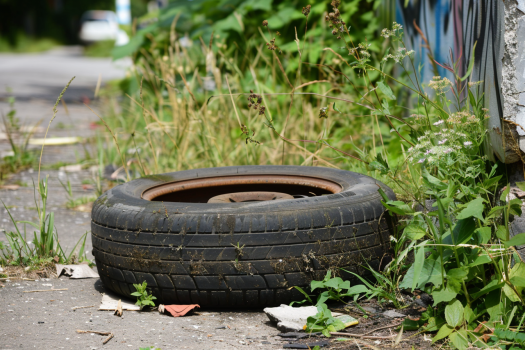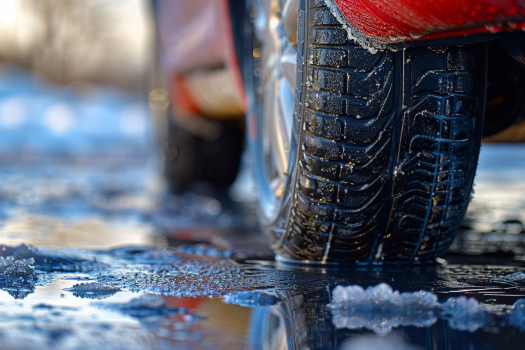Last Updated on April 25, 2024
Going the Distance: The Safe Range of Run-Flat Tires Revealed
Run-flat tires have recently gained popularity as an essential advance in in-vehicle technology. They are intended to add extra safety and convenience, especially in the event of a puncture or loss of tire pressure. This article will discuss the ins and outs of run-flat tires, including their design, benefits, and the significance of driving safely on them.
Understanding Run-Flat Tires
Run-flat tires, Also known as self-supporting tires, are designed to allow a vehicle to continue driving even after losing air pressure due to a puncture or other damage. Unlike ordinary tires, which fail quickly when punctured, run-flat tires are intended to maintain the vehicle’s weight for a limited distance and at a lower pace, often up to 50 miles at speeds around 50 mph.
This astonishing feat is made possible by the unusual construction of these tires. They are reinforced with thicker sidewalls and internal support structures capable of supporting the vehicle’s weight when the tire’s air pressure lowers. This innovation allows drivers to avoid the inconvenience and risk of changing a flat tire on the side of the road.

Importance of Safe Driving on Run-Flats
While run-flat tires offer many advantages, it is crucial to understand that they are not unseen. Safe driving practices remain essential when using run-flats, and there are limitations to their capabilities:
- When deflated, run-flat tires are not intended for high-speed driving. Excessive speed can generate heat, causing tire damage and decreased mileage. Staying within the recommended speed limit is essential for safety.
- Run-flat tires can only travel a specific distance following a puncture. It is usually best to drive to the nearest service station or tire shop as soon as possible to have a professional examine and repair completed.
- When deflated, run-flat tires may provide less handling and ride comfort than fully inflated tires. Drivers should anticipate these changes and adjust their driving accordingly.
- Many automobiles with run-flat tires include tire pressure monitoring systems (TPMS).
Factors Affecting Run-Flat Tire Mileage
Run-flat tires are essential in modern automobiles because they allow drivers to continue driving even when a tire is ruptured. However, the mileage of run-flat tires varies depending on several important factors. This article will examine tire type and brand, tire inflation pressure, vehicle load and weight, and road conditions.
Tire Type and Brand
The type and brand of run-flat tire you choose can significantly impact its overall performance and mileage. Here are some considerations:
- Tire Construction: Run-flat tires are created with various technologies and materials. Some might value durability and lifespan, while others concentrate on performance aspects. Choose a tire that meets your driving needs and preferences.
- Tread Pattern: The tread pattern on a run-flat tire can influence its mileage. Tires with a more aggressive tread pattern may wear out faster, mainly if used on smooth roads. Tread depth and design should be chosen according to your regular driving circumstances.
- Brand reputation: Reputable tire manufacturers frequently produce run-flat tires of higher quality and longevity. Researching and selecting tires from well-known companies might be an excellent way to maximize mileage.
Tire Inflation Pressure
Proper tire inflation is essential for both the performance and longevity of run-flat tires:
- Underinflation: Running run-flat tires at lower than recommended inflation pressures can increase heat buildup and tire wear. It can also reduce the distance the tire can travel when deflated.
- Overinflation: Overinflating run-flat tires can result in a harsher ride and reduced traction, potentially leading to uneven wear. For optimal mileage, it’s essential to adhere to the manufacturer’s recommended inflation pressures.
Vehicle Load and Weight
The weight your run-flat tires must support has a significant effect on their mileage:
- Vehicle Weight: Heavier vehicles exert more strain on the tires, resulting in faster wear. Ensure that your run-flat tires are acceptable for your vehicle’s weight class.
- Load capacity: Take note of the load rating of your run-flat tires. Overloading your car’s tire capacity can cause premature wear and reduce mileage.
Road Conditions
The condition of the roads you usually drive on can influence run-flat tire mileage.
- Smooth versus Rough Roads: Frequent driving on rocky or uneven roads might increase tire wear. When exposed to extreme road conditions, run-flat tires may have lower mileage.
- Potholes and Obstacles: Hitting potholes or road diets may cause damage to run-flat tires.
Several factors influence the mileage you can expect from run-flat tires. Choosing the right type and brand, maintaining proper inflation pressure, considering vehicle load and weight, and being mindful of road conditions are all essential steps in maximizing the lifespan and performance of your run-flat tires. Regular maintenance and cautious driving habits can go a long way in ensuring you get the most out of these innovative tire technologies.
Recommended Mileage Guidelines
Run-flat tires have accurate mileage limitations and recommendations from tire manufacturers and automotive experts. These instructions are essential to ensuring running-flat tires’ safe and efficient usage. This article will examine the manufacturer’s guidelines and offer practical advice for getting safe mileage out of your run-flat tires.
Manufacturer recommendations:
Tire manufacturers give essential information about their run-flat tires’ usage and mileage requirements. Here is what you should consider:
- Maximum Distance: Most run-flat tires are intended to travel up to 50 miles at a reduced speed (usually 50 mph) following a puncture. However, this distance may differ significantly based on the tire’s design and specs, so always refer to the manufacturer’s recommendations for your tire model.
- Speeding Limitation: Manufacturers recommend that you do not exceed a specified speed limit when driving on considerably deflated run-flat tires. Excessive speed can cause heat, potentially damaging tires and limiting mileage. Obedience to the recommended speed restrictions is critical for safety.
- Repairability: Manufacturers frequently specify whether run-flat tires may be fixed following a puncture. Some run-flat tires may be repairable in certain situations, but others may require replacement. When it comes to tire maintenance, always follow the manufacturer’s instructions.
Practical Tips for Safe Mileage
Apart from obeying manufacturer recommendations, there are practical tips you can follow to ensure you get the most out of your run-flat tires:
- Regular Inspection: Perform visual inspections of your run-flat tires regularly. Look for signs of damage, wear, or uneven tread. Early detection of issues can prevent potential tire failures and maximize mileage.
- Maintain Proper Inflation: Keep your run-flat tires inflated according to the manufacturer’s recommended pressures. Correct inflation helps distribute the load evenly and ensures optimal tire performance.
- Rotate Tires: Regular tire rotation helps promote even tire wear. Please consult your vehicle’s owner’s manual for recommended rotation intervals, which may vary depending on the vehicle’s drivetrain (front-wheel drive, rear-wheel drive, or all-wheel drive).
- Safe Driving Habits: Avoid harsh acceleration, abrupt braking, and aggressive cornering, as these can accelerate tire wear. Smooth driving habits can contribute to longer tire life.
- Vehicle Alignment: Ensure that your vehicle’s wheels are correctly aligned. Misaligned wheels can cause uneven tire wear, reducing mileage and handling performance.
- Balance Your Tires: Balancing your tires regularly helps maintain even wear patterns and ensures a smooth, comfortable ride.
- Proper Load Handling: Avoid overloading your vehicle beyond its recommended capacity. Excessive weight can strain run-flat tires and lead to premature wear.
- Be Cautious on Rough Roads: When driving on uneven or rough roads, exercise caution to minimize the risk of tire damage. Run-flat tires are designed to handle these conditions to some extent, but staying alert is critical.
Adhering to manufacturer recommendations and implementing practical tips for safe mileage is essential for getting the most out of your run-flat tires. Regular maintenance, safe driving habits, and proper load management can help ensure that your run-flats provide the expected performance and safety throughout their lifespan.
Signs of Tire Damage or Wear
Tire damage or wear is a common concern for all types of tires, including run-flat tires. Being vigilant and identifying early signs of tire issues is essential for safety and maintaining the longevity of your run-flat tires. This article will explore the visual inspection process, the importance of monitoring tire pressure, and how handling and ride quality changes can indicate tire damage or wear.
Visual Inspection
Visual inspection is one of the most straightforward ways to identify tire damage or wear. Regularly check your run-flat tires for the following signs:
- Tread Depth: Measure the remaining tread depth with a tread depth gauge. A considerable drop in tread depth may signal a need for replacement. Run-flat tires frequently include tread wear indicators that show up when the tread depth is critically low.
- Uneven Wear: Check the tread surface for irregular wear patterns. Irregular wear may indicate alignment concerns or incorrect tire pressure. If you observe that one side of your tire is wearing faster than the other, you must address the underlying issue.
- Cracks and Cuts: Check the sidewalls and tread for any apparent cracks, cuts, or bulges. Road hazards such as potholes or sharp objects can cause these, affecting tire integrity.
- Punctures: Look for any foreign objects, such as nails or screws, embedded in the tire. Even if your run-flat tires can continue driving after a puncture, addressing the issue promptly is essential to prevent further damage.

Monitoring Tire Pressure
Maintaining proper tire pressure is necessary for the performance and safety of run-flat tires. Here’s why monitoring tire pressure is essential:
- TPMS Alerts: Many modern vehicles with run-flat tires have a Tire Pressure Monitoring System (TPMS) that alerts you when tire pressure is low. Pay attention to these warnings and act promptly to address any issues.
- Underinflation: Run-flat tires can lose their ability to travel extended distances when underinflated. Low tire pressure can also lead to increased heat buildup and uneven wear. Use a reliable tire pressure gauge to check the pressure regularly, following the manufacturer’s recommended levels.
- Overinflation: Overinflating run-flat tires can result in a harsher ride and decreased traction. Check the tire pressure when the tires are cold (not right after driving) and adjust as needed.
Handling and Ride Quality
Changes in the way your vehicle handles or the quality of the ride can be indicative of tire damage or wear:
- Vibrations: If you experience vibrations or shaking while driving, it may mean tire imbalance or uneven wear. Seek professional inspection and tire balancing if this occurs.
- Reduced Grip: A noticeable decrease in the tire’s grip on the road can indicate tire wear or damage. This can impact your vehicle’s handling and safety, especially during inclement weather.
- Increased Noise: Unusual tire noises, such as thumping, screeching, or roaring, may indicate tire damage or abnormal wear. To avoid more issues, swiftly investigate and address the situation.
Recognizing signs of tire damage or wear is essential for maintaining the safety and performance of your run-flat tires. Regular visual inspections, monitoring tire pressure, and being attentive to changes in handling and ride quality are all crucial steps in ensuring that your run-flat tires serve you well throughout their lifespan. If you ever have doubts about the condition of your run-flat tires, consult a qualified tire professional for a thorough inspection and necessary maintenance or replacements.
Maximizing Mileage Safely
Achieving maximum mileage safely on your run-flat tires is essential for getting the most out of your investment and ensuring your safety. In this article, we will explore key strategies for maximizing the lifespan of your run-flat tires while prioritizing safety. These strategies include maintaining proper tire pressure, rotating run-flat tires, and adopting safe speed and driving habits.
Maintaining Proper Tire Pressure
Maintaining the correct tire pressure is one of the most critical aspects of maximizing the mileage and safety of run-flat tires:
- Recommended Tire Pressure: To determine the tire pressure, consult your vehicle’s owner’s manual or the manufacturer’s specifications. Run-flat tires are more sensitive to underinflation, resulting in lower mileage and an increased risk of damage.
- Regular Checks: Use a dependable tire pressure gauge to check your tires at least once a month and before long excursions. For reliable readings, measure the pressure when the tires are excellent (rather than soon after driving).
- Proper inflation: Inflate your run-flat tires to the prescribed pressure levels, as overinflation or underinflation might reduce their performance. Maintaining the appropriate pressure guarantees even wear and excellent tire performance.
Rotating Run-Flat Tires
Regular tire rotation is another necessary practice to extend the mileage and lifespan of run-flat tires:
- Rotation Frequency: Refer to your vehicle’s owner’s manual for suggested tire rotation intervals. Typically, run-flat tires should be rotated every 6,000 to 8,000 miles or as the manufacturer recommends.
- Even Wear: Rotating tires distribute wear evenly across all four tires. This practice is critical to extending their lifespan because run-flat tires are more prone to uneven wear.
- Alignment Check: Regularly check your vehicle’s wheel alignment and tire rotation. Proper alignment ensures that the tires wear evenly and maintain traction on the road.
Safe Speed and Driving Habits
Your driving habits play an essential role in ensuring both your safety and the longevity of run-flat tires:
- Adhere to Speed Limits: Respect speed limits and avoid driving at excessive speeds. Running run-flat tires at high speeds when deflated can generate heat and damage the tire, reducing its mileage potential.
- Avoid Rapid Acceleration and Braking: Smooth and gradual acceleration and braking reduce the strain on run-flat tires, promoting even wear and better mileage.
- Mind Road Conditions: Be cautious when driving over rough or uneven roads. While run-flat tires are designed to handle challenging conditions, driving carefully can help extend their lifespan.
- Avoid Overloading: Do not exceed your vehicle’s weight capacity. Overloading can stress the tires excessively, leading to faster wear and reduced mileage.
- Regular Inspections: As discussed in a previous section, conduct visual inspections of your run-flat tires for signs of damage or wear. Early detection and addressing issues promptly are crucial to maximizing mileage safely.
Emergency Situations and Run-Flat Tires
Run-flat tires are designed to maintain mobility even after a puncture or loss of air pressure, making them a vital safety element for drivers. This article will discuss run-flat tire situations, covering how to deal with punctures and flats and how to understand the limitations of run-flat tires.
Dealing with Punctures and Flats
One of the primary advantages of run-flat tires is their ability to keep you moving after a puncture. Here’s what you should know about dealing with punctures and flats:
- Monitoring Alerts: Many modern vehicles with run-flat tires have a Tire Pressure Monitoring System (TPMS). If you receive a TPMS alert showing pressure loss in one of your tires, remain calm and avoid sudden maneuvers.
- Keep Driving: Run-flat tires allow you to continue driving for a limited distance (typically up to 50 miles) at reduced speeds (around 50 mph), even after a puncture. This allows you to reach a safe location or a service facility.
- Caution Required: While run-flat tires provide mobility after a puncture, driving cautiously is essential. Avoid sudden accelerations, sharp turns, and hard braking, as these actions can strain the damaged tire and reduce its remaining mileage.
- Tire Inspection: Inspect the damaged tire once you’ve reached a safe location. If you find a visible puncture, assess its size and severity. Minor punctures may be repairable, but more extensive or severe damage may require tire replacement.
- Please consult a Professional: For tire repairs, it’s recommended to consult a qualified tire professional who can assess the damage and determine whether a repair is safe and feasible according to industry standards.
Limits of Run-Flat Tire Use
While run-flat tires offer significant advantages, they do have limitations:
- Distance and Speed: Run-flat tires are designed to cover a limited distance (typically up to 50 miles) at reduced speeds when deflated. Exceeding these limits can lead to tire damage and safety risks.
- Tire Condition: Run-flat tires are adequate after a puncture or loss of air pressure, but they are not invincible. Severe or extensive damage, such as sidewall tears or blowouts, may render them inoperable.
- Multiple Punctures: Run-flat tires are usually designed to handle a single puncture. If multiple tires are damaged simultaneously, the limitations of continued mobility may be exceeded.
- TPMS Alerts: Always heed TPMS alerts. Ignoring warnings and continuing to drive on significantly deflated run-flat tires can result in damage beyond repair.
- Replacement Timing: Run-flat tires that have been driven while significantly deflated or under adverse conditions may need replacement, even if they seem operable. Please consult with a tire professional to assess their condition.
When to Replace Run-Flat Tires
Knowing when to replace your run-flat tires is essential for safety and proper performance. This article explores critical factors to consider when determining if it’s time for a replacement, including tread wear indicators and age and shelf life considerations.
Tread Wear Indicators
Discover the importance of tread wear indicators on your tires. This blog explains how these small but crucial features can help you monitor tire health and safety and ensure you replace your tires at the right time.
- Tread Depth: Like all tires, run-flat tires include tread wear indicators molded into the grooves. These signs show elevated bars or marks on the tire. When the tread wears down to the level of these signs, the tire has reached the end of its useful life.
- Tread Depth Measurement: Measure the remaining tread depth with a tread depth gauge. Run-flat tires typically have 8/32 to 10/32-inch tread depth. Most experts support replacing tires when they have a remaining tread depth of 2/32 inches or less, which is the legal maximum for safe tire use in many areas.
- Uneven Wear: Even if the tread depth appears adequate, variable wear patterns can show the need for replacement. If one part of the tire has less tread than others, it’s a sign of irregular wear, affecting handling and safety.
- Tire Rotation: Regularly rotating your run-flat tires can help ensure even wear and maximize lifespan. Consult your vehicle’s owner’s manual for recommended rotation intervals, typically every 6,000 to 8,000 miles or as the tire manufacturer advises.
Age and Shelf Life Considerations
Examine the elements that influence tire age and shelf life. We’ll examine why a tire’s age matters, how it affects performance and safety, and the best techniques for managing tire storage to maximize longevity and reliability.
- Tire Age: Like other tires, run-flat tires can degrade over time, even if they have many treads left. Rubber reduction can be caused by several factors, including heat, sunshine, and time. Experts usually advocate changing six or older tires, regardless of their visible conditions.
- Manufacture Date: To determine a tire’s age, look for the DOT (Department of Transportation) code on the sidewall. The last four digits indicate the week and year of manufacture. For example, “2518” would mean the tire was manufactured in the 25th week of 2018.
- Shelf Life: Tires stored for an extended period, such as spare tires or those kept as replacements, may also require replacement, even if they appear unused. The shelf life of tires can vary based on storage conditions, but experts generally recommend replacing stored tires after six years.
- Tire Inspection: Regularly inspect your run-flat tires, even if they have not reached the recommended age limit. Look for signs of sidewall cracking, dry rot, or visible reduction. These show that the tires are no longer safe, even with sufficient tread depth.

Conclusion & Recommendations
After looking into the various aspects of run-flat tires, including understanding their construction, factors affecting mileage, dealing with emergencies, and knowing when to replace them, it’s essential to summarize the key points and offer recommendations for ensuring safety and longevity on run-flat tires.
Recap of Key Points
This blog provides a complete overview of the key points from our tire-related discussions. Whether you want to brush up on tire maintenance, industry trends, or purchasing considerations, this summary will provide a quick and helpful overview of the critical issues discussed in our tire-focused blogs.
- Understanding Run-flat Tires: Run-flat tires are designed to maintain mobility even after a puncture. They achieve this by using reinforced sidewalls and internal support structures.
- Factors affecting mileage: Several factors influence the mileage from run-flat tires, including tire type, inflation pressure, vehicle weight, and driving circumstances.
- Emergency Situations: Run-flat tires offer the advantage of mobility after a puncture, but it’s crucial to drive cautiously and consult professionals for tire repair or replacement when necessary.
- When to Replace Run-Flat Tires: Pay attention to tread wear indicators and the age of your run-flat tires. Regular inspections and proper maintenance are crucial to safety and longevity.
Ensuring Safety and Longevity on Run-Flat Tires
To ensure both safety and longevity when using run-flat tires, consider the following recommendations:
- Regular Maintenance: Maintain proper tire pressure, rotate your run-flat tires as recommended, and adhere to safe driving practices. Routine maintenance plays a crucial role in maximizing tire lifespan.
- Tire Inspection: Visually inspect your run-flat tires for signs of damage, uneven wear, or punctures. Address issues promptly to prevent safety risks and extend tire life.
- Tire Age: Keep an eye on the age of your tires. Replace run-flat six or older tires, even with sufficient tread depth.
- Drive Cautiously in Emergencies: When faced with a puncture or loss of pressure, drive carefully and within recommended speed limits. This ensures both your safety and the potential for continued mobility.
- Professional Assessment: Consult with qualified tire professionals for repair, replacement, and alignment services. Their expertise can help you make informed decisions about your run-flat tires.
Buy Run-Flat Tires at Tire Easy
tire Easy has an extensive range of run-flat tires to suit different cars and preferences. Our user-friendly web platform lets you discover, compare, and purchase the best run-flat tires. Choose high-quality tires from a reliable source to ensure your safety and longevity on the roads.
Ready to ensure your safety and maximize the lifespan of your run-flat tires? Please browse our extensive collection of run-flat tires at Tire Easy today. By selecting the right run-flat tires from our inventory, you can make the smart choice for your vehicle’s safety and performance.
Invest in the safety and longevity of your run-flat tires by purchasing from Tire Easy. Your journey to a secure and smooth ride begins here.
FAQs
How far can I drive on a run-flat tire?
After a puncture, run-flat tires can typically travel up to 50 miles at reduced speeds (around 50 mph).
Is it safe to continue driving on run-flat tires?
Driving on run-flat tires for a limited distance after a puncture is safe, but moving cautiously and within recommended speed limits is crucial.
What is the maximum distance you should drive on a flat tire?
The maximum distance you should drive on a flat tire depends on the type of tire and the specific circumstances. Run-flat tires are designed to go up to 50 miles when deflated.
How many miles do run-flat tires last?
The mileage of run-flat tires varies depending on factors such as tire type, maintenance, and driving habits. On average, they can last around 30,000 to 50,000 miles.
How far can you drive with a run-flat tire?
Run-flat tires can typically cover up to 50 miles at reduced speeds after a puncture.
Is it safe to continue driving on run-flat tires?
Yes, it is generally safe to continue driving on run-flat tires for a limited distance after a puncture. Still, it’s essential to exercise caution and not exceed the recommended speed limits.
How many km is a run-flat?
When deflated, run-flat tires can travel up to approximately 80 kilometers, depending on the specific tire model and conditions.
How safe are run-flat tires?
Run-flat tires provide added safety by allowing you to maintain control and mobility even after a puncture. However, they have limitations, so using them according to manufacturer recommendations for maximum safety is essential.










